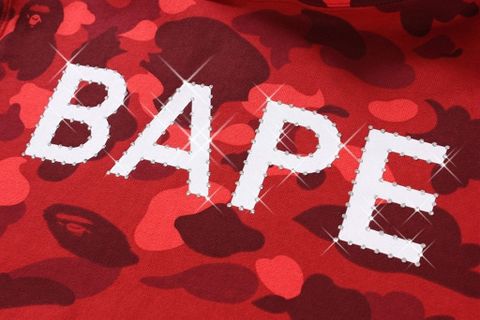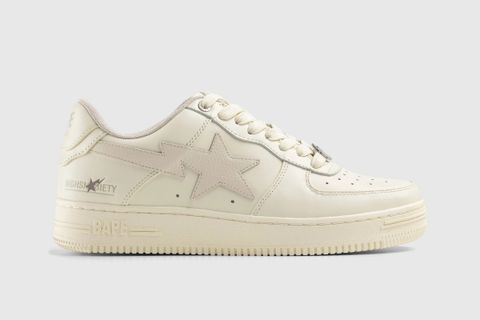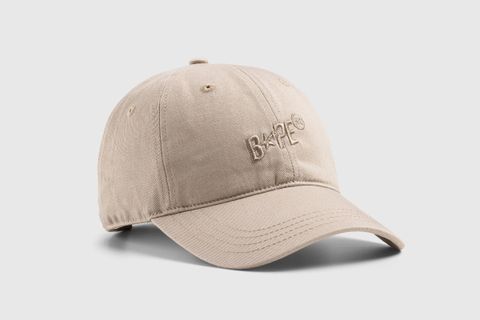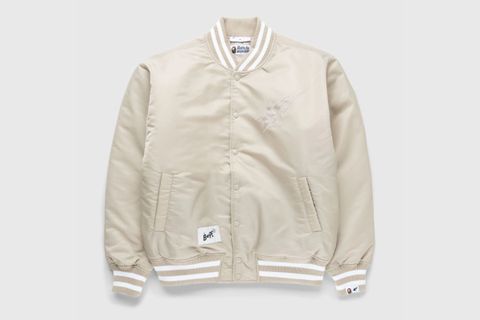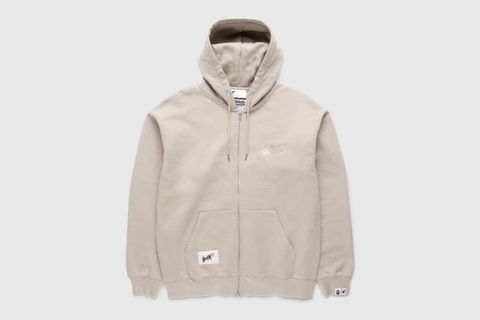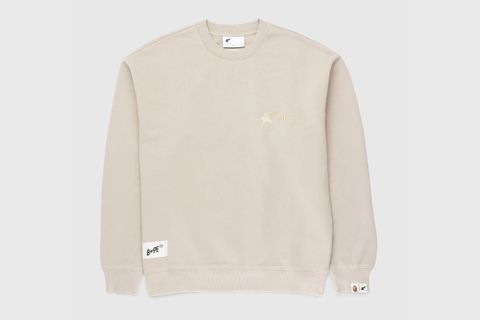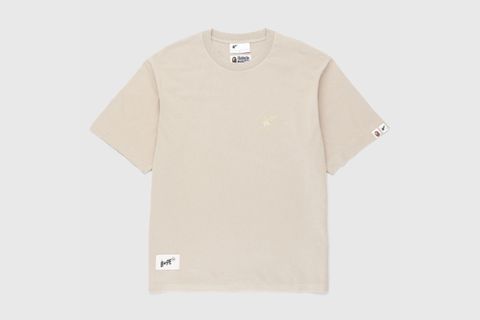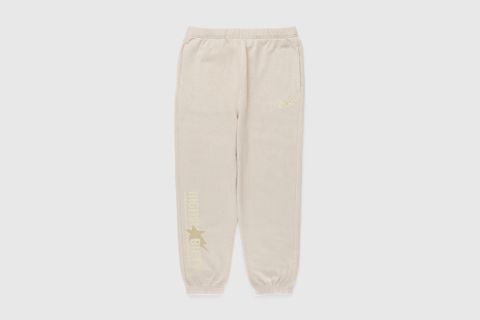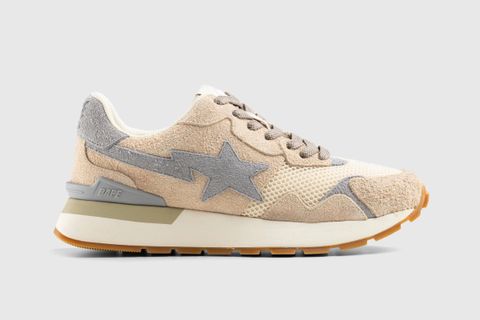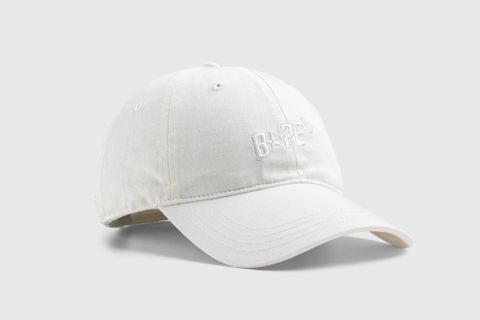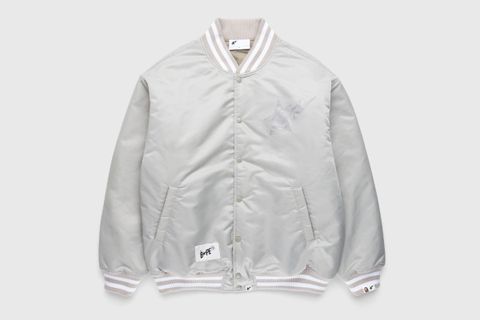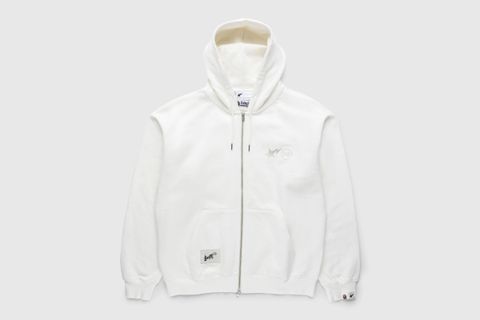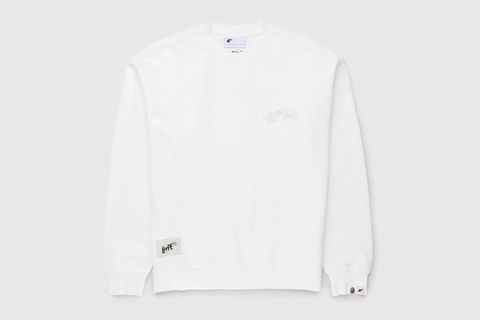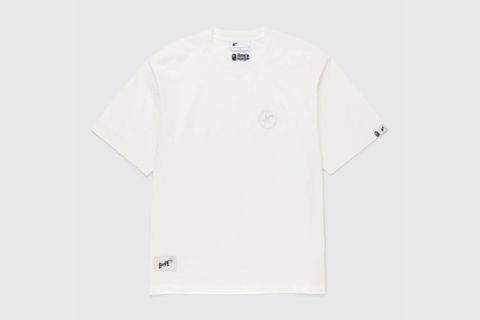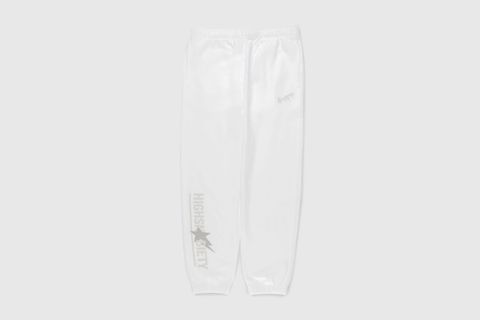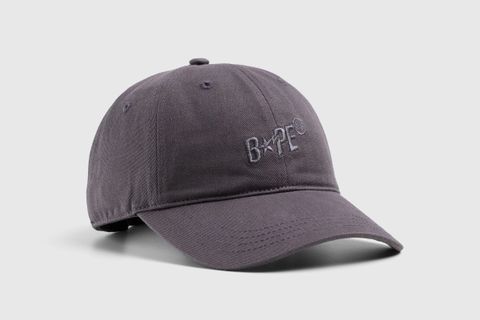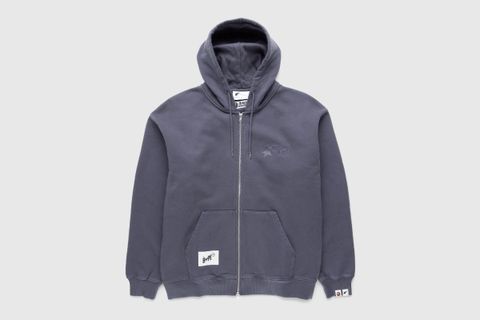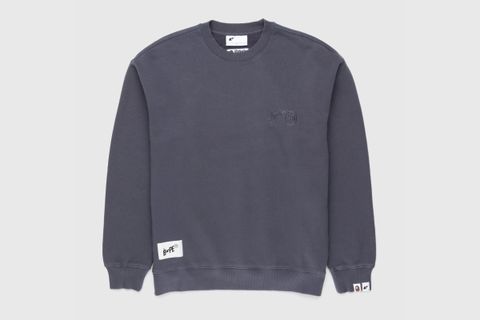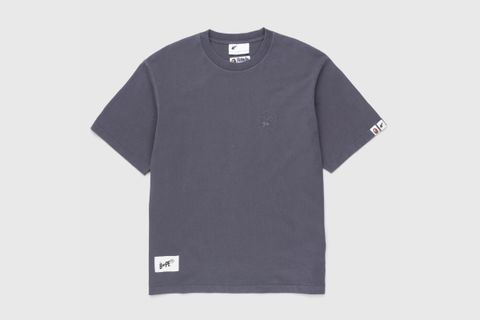Everything You Ever Wanted to Know About BAPE (and Some Things You Didn't)
The latest BAPE x Highsnobiety collection is available to shop now. Be sure to check out the full collection on the Highsnobiety Shop.
The year is 2023, and BAPE is one of the most hyped brands in streetwear. When you first discover this culture and start doing your history research, Nigo’s label, aka A Bathing Ape, is in Chapter One. But as we’ve discussed at length over here lately, the last few years have been interesting for streetwear, because now it’s mainstream.
In an age where music is virtually free and everything else is little more than a click away on the internet, the youth have turned their attentions (and their wallets) to fashion and clothes as the means of expressing themselves. In any major developed city around the world, you’re likely to see kids wearing box logos. Style-conscious consumers, from your 6-year-old cousin to your law firm partner uncle, are looking for a pair of Dunks. And Palace Skateboards is globally renowned as being "better for bunning".
In times like these, you’d be totally forgiven for assuming this is the way things had always been. Personally, I struggle to wrap my head around the fact that Supreme London now has queues around the block virtually every single day, when only a few years back it was a race between about 20 of the same guys to get to Hideout (RIP) on a Saturday morning in the hopes of being able to buy one of the three caps they may or may not have received on that particular week. Don’t get me wrong; this isn’t some “old man yells at cloud”-esque ‘you kids don’t know how good you’ve got it’ rant. All I’m saying is things have changed.
With the hype more fervent than ever, it feels like what sometimes gets lost is the perspective of a style movement that’s been going for over 25 years now, and nowhere is that more evident than with A Bathing Ape. The brand has experienced a return to vogue amongst the general consumer these days, with kids eager to own their own piece of clothing adorned with the iconic BAPE camo pattern.
What gets lost in the current trends, I worry, is the virtually dynastic history of the brand and its founder, Nigo. Supreme might be the master of the weekly hype machine these days, but it was A Bathing Ape that arguably created the model, and not without a few bumps along the way. So here’s a guide to the history, hype, and hysteria of one of streetwear's first true “lifestyle brands” – A Bathing Ape.
Origins of the Iconic BAPE Logo
Like most of the Japanese streetwear icons, BAPE's roots can be traced back to the ura-Harajuku scene of the early ’90s. Most of today’s heavyweights — Shin Takazawa of Neighborhood, Tetsu Nishiyama of WTaps, Hiroshi Fujiwara, Sk8thing and so on — were actually a group of friends in the same scene, each doing their own thing and helping each other out along the way.
After a few years working as an editor and stylist at Popeye magazine, Nigo opened up his store ‘Nowhere’ with Jun Takahashi of Undercover, and shortly after worked with Sk8thing to launch his own clothing brand, A Bathing Ape — or BAPE.
Nigo is a notorious fan of 20th century pop culture, and channelled his love for the 1968 film Planet of the Apes in the name and iconic BAPE logo, as well as referring to the Japanese idiom ‘A bathing ape in lukewarm water.’ The phrase is used to describe somebody who overindulges, like lying in a bath until the water isn’t even hot anymore, so was an almost tongue-in-cheek reference to the same hyper-consumptive youth that would eventually form the cornerstone of his brand.
Big in Japan
With its mixture of imported American street and sportswear and pioneering Japanese streetwear labels like WTaps-predecessor Forty Percents Against Rights, Nowhere quickly became a cornerstone of the burgeoning ura-Harajuku scene, with Nigo as one of its figureheads.
Alongside Neighborhood, Hysteric Glamour and other such brands, A Bathing Ape and Nowhere helped to define the "Urahara" style of the ’90s. Urahara comes from the term ‘ura-Harajuku’ which basically means “underground Harajuku” – the underground scene going during the early ‘90s which was heavily informed by a mixture of various American clothings and styles.
Through associations with the International Stüssy Tribe and James Lavelle of UNKLE & Mo’Wax records, BAPE was quickly established as a cultural tastemaker in Tokyo, as well as a best-kept secret in closed circles abroad – someone's friend would go to Japan, bring back some clothes and a few magazines, and the hype would slowly spread through word of mouth alone.
The Power of Exclusivity
The original reason for BAPE's scarcity was arguably one of financial necessity – Nigo started out on a tight budget and only afford to produce around 50 T-shirts a week – but he also disliked the idea of everyone wearing the same thing.
By 1998 the brand was stocked in around 40 locations across Japan, but Nigo then made the bold move of canceling all wholesale operations, instead focusing all of his energy on a single flagship location in Tokyo. Sales quickly exceeded their previous levels and the fundamental streetwear formula of hype, scarcity and public spectacle was born — and arguably birthed streetwear's queuing culture that we know and love (or loathe) today.
The Pharrell Years
The late ’90s to early ’00s are generally cited as the golden era of BAPE, with product rapidly selling out in Japan and fashion-savvy figures like The Notorious B.I.G. giving the brand some healthy kudos in hip-hop culture. In the early ’00s Nigo was introduced to Pharrell Williams through Jacob the Jeweller, who noted the two’s similar tastes in jewelry commissions.
Well-known for his laidback persona and youthful free spirit, BAPE’s bright and flashy aesthetic fit perfectly with Pharrell’s personal style, and his success was coupled with a greater attention being paid to BAPE stateside, though the brand remained scarce due to the absence of American stockists.
In 2005, Pharrell and Nigo partnered up on the N*E*R*D frontman’s Billionaire Boys Club & Ice Cream clothing lines, and the flashy, playful and oversized aesthetic of BAPE became a mainstay of millennial hip-hop fashion. In 2005 and 2006, BAPE's first overseas flagship stores were opened in New York and Los Angeles, and Kanye West designed his own pair of the brand’s coveted Bapesta sneaker.
Then, in 2007, the notorious video for Soulja Boy’s ‘Crank Dat’ was released, featuring Soulja Boy’s own Bapestas heavily (though their authenticity has been called into question) along with the line, ‘I got me some Bathin’ Ape’. That was it; BAPE entered the cultural zeitgeist and claimed its throne as the pinnacle of flashy, expensive streetwear.
The Steady Decline & Nigo’s Departure
Though the BAPE story wouldn’t be the same without its meteoric rise to success in the States, the brand’s newfound popularity brought with it a number of problems. Scarcity of product in the U.S., combined with BAPE’s unusually high prices for young western consumers, led to the proliferation of counterfeit product, saturating the market before the brand could find its feet. BAPE's relatively-sudden explosion also meant that its popularity became more of a fad or passing trend than the slow and carefully-cultivated hype that it had built in Japan.
By 2010 the brand had fallen out of vogue, and it emerged that A Bathing Ape had amassed over 2.5 billion yen ($22.5 million) in debt. Nigo stepped down from the company as CEO, and in 2011 the brand was sold to Hong Kong fashion conglomerate I.T for a paltry $2.8 million. Over the next two years Nigo stayed with the company to assist with the transition, launching his new vintage-inspired label Human Made and taking on a new role as Creative Director of Uniqlo’s ‘UT’ T-shirt line.
BAPE Today
Since its acquisition by I.T, BAPE has settled as a mainstay label of contemporary streetwear; though the brand is nowhere near as scarce and unpredictable as it used to be, its legacy as one of the original streetwear icons, as well as its deep connections in hip-hop and street culture, has seen the brand endure with a much broader audience.
Once-coveted rarities like BAPE shark hoodies and insulated snow jackets have become mainstay pieces every season, and the brand's iconic camo is now one of the most prolific graphics of contemporary street style. To many of the older heads, the BAPE of today has little in common with its roots, but whether that’s a good or bad thing is, frankly, a matter of perspective. In 2017, it’s still a brand defined by its young, consumptive audience’s voracious appetite for anything on offer, so in many ways it’s the same as it ever was.
Buying BAPE Online
One of the hardest parts of buying BAPE online in the early ’00s was the lack of official or reputable outlets on the Internet, making it a much bigger gamble grabbing pieces off of eBay or online forums.
Fortunately that’s not so much the case these days, with the BAPE online store offering a healthy selection of product over at bape.com, as well as trusted retailers like END., Selfridges and Undefeated coming through with a strong offer every season. Even looking for older pieces and forgotten relics is much easier thanks to the likes of Grailed, Depop and Facebook buyer/seller groups, whilst eBay has become a much easier place to navigate.
Be warned, however; the risk of buying counterfeit product from an unofficial seller is as real as ever, but there are comprehensive guides on how to identify fakes available with a simple Google search. If you’re not an expert on BAPE product (and to be honest, even if you are), take the time to learn what you’re buying and save yourself the hassle of opening up a package full of fake garments bought from some sketchy BAPE Online Discount Bargain Super Value Outlet.
Pro-tip: I can’t speak for other countries, but in the UK if you purchase something online with a debit card which turns out to be fake, you’ll have a hard time getting your money back. If you pay with a credit card, however, your bank will reverse the charge immediately and leave it up to the seller to prove the product’s authenticity. Credit cards – not always your worst enemy.
Buying From a BAPE Shop
If you’re not fortunate enough to live in Tokyo, buying BAPE at an actual store can be a real task. For a long while in the UK and the United States, product stayed pretty much tied up exclusively in the brand's flagship stores. Since I.T’s takeover, however, things have laxed up a little bit, and there are loads of options for where to buy BAPE, with the added luxury of trying it on before you buy.
In the UK, there’s now a permanent BAPE shop in London’s Selfridges department store, decked out in the brand’s inimitable camo and neon décor, while END.’s two brick-and-mortar locations in Newcastle and Glasgow have got the Northern customers well-catered for.
As for the USA, beyond the BAPE shop in New York, many of the heavyweight streetwear retailers such as RSVP Chicago and Concepts Boston are certified stockists of the brand, while Undefeated’s stores have got the West coast well and truly covered.
Asian heads have the best deal, naturally. You'll find a BAPE shop in every corner of Japan, with myriad outposts dotted around China, Hong Kong, Singapore, Korea, Taipei and Thailand.
Head to the BAPE online store for a full list of brick-and-mortar retailers.
Why is BAPE so expensive?
Very few discussions about BAPE ever pass by without that vital inquiry; just why, exactly, is BAPE so expensive? The thing is, with a lot of Japanese brands, there’s a long list of reasons behind their pricing structure; higher standards of quality, better healthcare and wages for Japanese manufacturers, a consumer perspective in Japan that good product is worth having and worth paying the price for, and so on.
The thing with BAPE though, these days at least, is that none of that is really the case. The product is mostly made in China. The quality, though still good compared to your average mall brand, is really nothing special. And as for its reputation in Japan, BAPE is hardly an exceptional label. In fact, it’s so common over there that most people probably wouldn’t bat an eye at it.
So why is BAPE so expensive? Sit down for the revelation: because it just is. Remember the meaning behind the name? Complacent and over-indulgent youth? Ding ding ding. BAPE is expensive because it’s an expensive brand for kids with too much money, and that tongue-in-cheek treatment of its customer just ended up also being one of its strongest appeals.
Of course, there’s also the fact that a premium brand has to charge premium prices to maintain the customer’s view of it, but there’s really not much else there to BAPE. The brand’s “patent leather” Bapesta sneakers were often made of plastic and cracked and chipped after just a few wears. The T-shirts, though definitely a cut above once upon a time, are now just bog-standard tees with a little woven label, and the rest of the garments, however well-made and layered with details, are still made in China for Chinese labour costs. So yeah. BAPE is expensive because BAPE is expensive. Tune in next week for more grand revelations.
Behind the BAPE Shark Hoodie
Alongside a handful of items like the Bapesta, camo outerwear and legendary lifestyle products, the BAPE Shark hoodie is probably one of the most iconic garments in A Bathing Ape history. First released in 2004, its outlandish design and slew of unique details really pushed that idea of BAPE as offering something that you couldn’t get anywhere else. It was a perfect blend of timely stylishness and quirky gimmicks that meant anyone wearing it was destined to turn heads, and just like Supreme’s own super-hyped box logo hoodies, was characterised by its scarcity and various iterations which meant anyone who bought one felt like they were getting their own little piece of exclusivity.
The hoodie’s distinctive ‘shark’ design on the hood is actually taken from military artwork that would be placed on the nose of fighter planes or even the hulls of battleships. The distinctive tiger ‘a’ symbol obviously stands for A Bathing Ape, while the accompanying ‘WGM’ chenille varsity patches stand for ‘World Gone Mad’, and the full-zip hood feature was a somewhat anomalous feature at the time which opened the Shark Hoodie up to all sorts of edgy and unique photo opportunities. While the original BAPE Shark hoodie featured a simple block-color with a half-woodland camo hood, later iterations would incorporate other Bape insignias into their designs, such as BAPE Camo, the Bapesta Star and the brand’s distinctive plaid pattern.
Though the BAPE Shark Hoodie is a lot easier to get hold of today than it was when it first released, it remains a coveted piece of streetwear history for a number of reasons. Firstly, it’s so distinctive that anyone “in the know” who sees it immediately knows what it is. Secondly, averaging at around $300 retail, they’re expensive as hell which, coupled with the first point, makes it highly appealing to the streetwear community's love of letting other grown men in the street know how much money they spent on a piece of clothing from just a glance.
Behind the BAPE Camo
Also known as the ‘Cloud Camo’, the iconic BAPE Camo print is perhaps the most fascinating element of the brand, as a graphic which has totally transcended streetwear to become one of the most iconic motifs of the past two decades.
The graphic blends a number of different elements in its design; firstly, its obvious reference to military camouflage fits perfectly with the Japanese (and entire fashion world’s) fascination with military clothing. Where camouflage is traditionally designed to conceal and hide, however, the BAPE camo manages to flip the script and become something that you just can’t ignore.
Secondly, with its blobby, “hyperflat” design inspired by traditional duck-hunting camouflage, BAPE camo brings the glossy, cartoon-esque, fun and fantastical element of Japanese fashion to life without being kitschy or corny. Tokyo is the home of Hello Kitty, anime, collectible dolls and kawaii culture, and there’s unquestionably an element of that in that splodgy, super-smooth motif. It makes military seem less serious, and it makes irreverence seem more dignified.
But thirdly, and perhaps most interestingly, it’s worth considering BAPE camo in the light of Nigo’s idol – Andy Warhol. Just as Andy Warhol wanted to make everyday, mass-manufactured culture into a work of art, there’s something very high-meets-low culture in the way Nigo has plastered BAPE camo in blue, pink, red and green onto any surface he can get his hands on.
Over the years BAPE have released their own-brand fishing gear, transformers dolls, condoms and even toilet roll, but the moment you put an object in camo, it’s no longer simply an object. It’s BAPE. Seriously; how many people do you think actually took that BAPE toilet roll home and used it? And how many do you think still have it sitting on a shelf in their living room? Toilet roll. On display. That’s real power.
Behind A Bathing Ape x adidas Originals
The BAPE sneaker hype was fired up again not too long ago with the release of a BAPE camo iteration of adidas’ instant sell-out NMD silhouette, but there’s a lot more to BAPE x adidas Originals than meets the eye.
The idea of a collaboration first came to light in the early ’00s when Nigo was introduced to adidas brand consultant, and founder of adidas Spezial, Gary Aspden through Stone Roses singer and notorious BAPE head Ian Brown.
Working closely with revered Japanese designer Kazuki Kuraishi, Nigo and Aspden facilitated the creation of four ‘Super Ape Star’ silhouettes which incorporated key BAPE insignia and motifs into the iconic adidas Superstar silhouette. This was later followed by four mid-top ‘Super Ape Skate’ silhouettes which revived the hype.
It was a long time before the brands would meet again in 2011, but the significance of the first BAPE x adidas Originals releases shouldn’t’ be underestimated. In 2003 the idea of a sportswear brand collaborating with anything other than an athlete was virtually unheard of in the west. Having only just launched in 2001, adidas Originals dared to join forces with another brand under the powerful mantra of ‘The Respect is Mutual’ and do something completely different.
Judging by everything that’s happened in the years that followed, BAPE x adidas was the right gamble.
BAPE: It’s a Lifestyle
As mentioned earlier on in this article, BAPE was one of the first fashion labels to create products encompassing every corner of everyday life, allowing streetwear fans to literally live a BAPE-branded lifestyle. Beyond clothes and sneakers, the brand has produced kitchenware, furniture, toiletries, fishing hooks, bed linen, skateboards and much more. Nowadays every brand produces wildcard products, from Supreme and Palace all the way up to Louis Vuitton and Comme des Garçons, but BAPE was one of the true pioneers of the “lifestyle brand” concept.
Beyond BAPE: Human Made
When Nigo sold BAPE to I.T in 2011, it signalled the end of an era in streetwear. Fortunately, Nigo didn’t sit still for long before moving on to new endeavors. Though he stayed with the company for two years as a Creative Director, he quickly launched his new brand, Human Made. Drawing from Nigo’s fascination with vintage American workwear, Human Made saw the designer working with Japanese reproduction specialists Warehouse Japan on creating high quality clothing inspired by authentic pieces from Nigo’s archive.
Compared to the bright, poppy, futuristic aesthetic of BAPE, the brand was a stark departure from his previous output, but some signs of his influence remained – a number of graphics were designed by long-time Nigo collaborator (and C.E founder) Sk8thing, the BAPE logo featured an ape’s face, and interior labels even featured a line from a Planet of the Apes film: ‘You are scientifically advanced but there remains a question as to how civilized.’ Oh, and it’s really fucking expensive, so that hasn’t changed.
Beyond BAPE: The Sotheby’s Auction
If the multitude of references in his designs wasn’t a big enough clue, Nigo is a notorious pop culture fanatic, collecting all sorts of ephemera from over the years; Star Wars figurines, Warhol paintings, games consoles, Eames furniture, cars and much more.
In late-2014, Nigo set streetwear heads and pop culture collectors alike drooling with the announcement of an auction of his collection, presented in association with famed auction house Sotheby’s. Original Batman toys were offered alongside custom Goyard luggage, luxury watches, BAPE camo couches, even a Gucci Christmas tree designed by Tom Ford. Many of the pieces ended up selling for prices far beyond the estimates, proving yet again that outsiders will always underestimate the fanboyism of streetwear heads. Full BAPE camo couch for $20,000? Can’t even hate, I would too.
Beyond BAPE: AAPE by A Bathing Ape
When Nigo initially sold A Bathing Ape to I.T, there were plenty theories floating around the rumor mill as to what motivated the sale. One of the more popular theories was that BAPE was in pretty bad financial straits — not so hard to believe considering Nigo’s well-documented frivolous spending.
Whether there’s truth to these rumors or not, there’s no doubt that one of the first things I.T did when they took control was implement a stable, profitable business model. Coveted grails became regular items, BAPE camo became more prominent than ever, and the collaboration machine went into overdrive.
One of the more unexpected introductions, however, was the creation of a new sub-label: AAPE by A Bathing Ape. Releasing at a slightly lower price point with subtle aesthetic differences in its design language, AAPE by A Bathing Ape was targeted at the mainstream Asian market in China, Hong Kong and beyond as well as more casual consumers around the world.
As many BAPE fanatics quickly worked out, AAPE by A Bathing Ape was just similar enough that your average teenage shopper wouldn’t care that it wasn’t BAPE-proper, but just different enough that perception of the OG BAPE brand wouldn’t be damaged by BAPE aficionados. As the saying goes, if it don’t make money, it don’t make sense.
In a further move to mainstream profitability, BAPE would also go on to introduce a kids line, filled with cutesy versions of garments found in the brand's mainline.
Beyond BAPE: A Bathing Ape Black
A few years back when the Raf Simons/Rick Owens hype was arguably at its peak, pretty much every single streetwear brand out there was creating blacked-out collections making heavy use of slim, extended silhouettes, drop-crotch pants, draped layers and minimalist graphics. Never one to miss a trick, A Bathing Ape joined in with their own sub-line, A Bathing Ape Black.
More conventional than some of the other offerings, A Bathing Ape Black offered a range of essential BAPE designs in blacked-out color palettes, decorated with flashes of gold. The emphasis was quality and luxury, with embroidered details and premium materials, while lookbooks modeled by Chris Brown and Travi$ Scott cemented the aesthetic. I guess when you’ve built a reputation for expensive streetwear, the only direction to go is more expensive, right?
Beyond BAPE: Uniqlo UT
In 2013, Nigo achieved what might be any pop-art inspired creative’s dream when he was hired as Creative Director for Uniqlo’s graphic t-shirt line, UT. Far from days of printing 50 t-shirts a week and working on a shoestring budget, he’s now the head honcho of one of the most broadly accessible clothing brands on the planet.
As you might expect, a large element of his work has been going through the Rolodex, connecting old friends with the high street heavyweight, and highlight releases have been his collaborations with Kaws, Futura, Coca-Cola and Asian instant messaging app Line. Selling out a couple hundred t-shirts is one thing. But selling out a KAWS collaboration globally? Twice? Different level.
BAPE opens new store in Paris
BAPE tied up 2017 with the announcement of their second European retail space, this time in Paris. To celebrate the new store opening, BAPE decked a Jaguar F-Pace is red/white/blue BAPE cloud camo (vive la France) and drove it around some of the French capital's most iconic locations.
The new interior featured metallic/glass furnishings, a neutral color palette, clean lines, framed graphic tees and notably, a pixelated BAPE camo print on the wall. Located on 34 Rue de la Verrerie (not more than a 10 minute walk from the Paris Supreme store), Highsnobiety went down to livestream the opening event with music from Busy P of Ed Banger records.
BAPE x Highsnobiety
Linking up for our fourth collection, the latest BAPE x Highsnobiety release is a full 19-piece drop. Utilizing three major color tones (ivory, beige, and charcoal), the collection offers a matching uniform all the way up from co-branded baseball caps down to limited-edition sneakers.
The collection focuses on the brand's iconic STA branding and includes the first product to ever feature that logo: the BAPE STA. The co-branded sneaker is decked out in neutral-hued leather with a contrasting, textured caviar leather STA logo running along the sides of the upper. Further detailing on the limited-edition shoe includes an APE HEAD lace charm and double heel tab.
Shop BAPE x Highsnobiety
For a bigger scoop of BAPE, watch below.
Now read about every UNIQLO collaboration you need to know about, from UNDERCOVER to Japanese Ramen restaurants.

